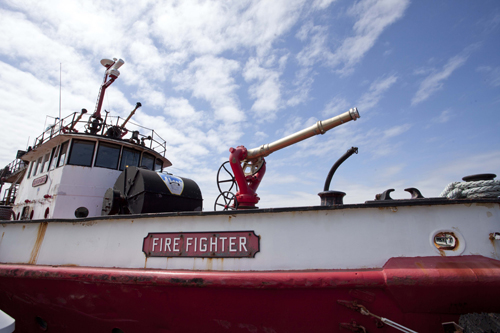Guest: A reminder of what the U.S. is made of

Fire Fighter is America’s fireboat. Presumptuous, maybe, but Fire Fighter represents everything about America that was and is good.

The die was cast for Fire Fighter. Laid down at the height of the shipbuilding industry in a country approaching World War II and designed by premier Naval architect William Francis Gibbs, she was bound for greatness — and great things she did. A National Historic Landmark since 1989, a Gallant Ship award recipient in 1974 and one of the Heroes of the Harbor who came to the aid of those embedded in the tragedy of 9/11, this vessel is truly the most famous fi re-boat in the world.
If you are curious and decide to read about her, you will fi nd historic records of the many fires and rescues as well as the staggering capabilities of a vessel built a long time ago, in 1938, years ahead of her time, with physical attributes that would eventually have engineers calling her “the most powerful fi reboat in the world.”
Her hull design, amazing engine room and battle-ready capabilities as a fi refighting apparatus are testament to her 72 years of service to the City of New York.
Although these things alone prove her value to the citizens she protected and the men who served as crew, there’s something a bit more intangible that stands out about Fire Fighter.
Nothing is more apparent and enduring than the love people have for this special boat. Many of these people are from all over this country, this world; many of them FDNY firemen and crew, many volunteer firemen from this area and some who knew her just one time in their lives and the memory stuck. One gentleman, who looked to be in his 70s, approached me recently and asked where she was docked originally. I responded, “In lower Manhattan and Brooklyn.” His eyes lit up with surprise. He pointed at the boat and said, “That’s the same fi reboat I went on when I was 10 years old on a school trip.” It was another speechless moment for me. This boat continues to surprise me with its living history and the lives it has touched.
My days in Greenport Village have proved that to me.
In its first year as a floating museum in Greenport, many people have visited Fire Fighter. Aside from the few who commented on her aging appearance and seemingly impossible restoration process, many talked of events, people or circumstances that somehow connected them to the boat. During this time, the most peculiar thing said to me might simply have been, “Thank you” — not for giving the tour or sharing my knowledge of the vessel, but “for saving her” — to which I had no reply.
The reason the boat means so much to me, and many others, is that every piece of equipment that has performed on this vessel, endured and stood fast under stress was built right here in America. At a time when we were noted the world over for building things — and building things well. Reminders that represent these moments in history must endure, or we are destined for mediocrity.
Roughly a year ago, just after a big snowstorm, a volunteer crew shoved Fire Fighter off from FDNY Marine Headquarters at the Brooklyn Navy Yard. We cruised at some points well above 15 knots and arrived at the east dock in Greenport at 4:30 p.m.; 100 miles in just nine hours for a supposedly ailing, decrepit old boat. Not a drop of sea water came inside Fire Fighter’s hull that day — and since docking in Greenport, not a drop has leaked through its alleged permeable hull.
Since arriving in Greenport, our mission has always been to integrate the museum into the town’s culture and slowly do our restoration work, increase our programming, and recruit area volunteers and supporters. This past year, despite our detractors’ efforts, we prevailed and saw hundreds if not thousands of visitors cross our rails to see this great piece of history. We also recruited valuable volunteers from the area, retired mariners like Henry Wassmer from Southold, who served as Fire Fighter’s chief engineer for 17 years.
It’s his boat really; we are just borrowing it.
It seems to me the controversy in Greenport that may lead to Fire Fighter’s having to leave the area can be summed up in one phrase: “What if?”
Some have chosen to pose their “what ifs” in the negative vain: What if you sink? What if there is a storm? What if there are fuel leaks? I would like to pose some “what ifs” of my own to the people of Greenport and see if they share our vision.
What if the village allowed us to stay, continue to restore the boat, attract visitors to an often lonely part of town and offer tours and programs to the public — all for free? What if, in the next year, more supporters and donors came to her aid, grants were awarded and Fire Fighter got the well-deserved shipyard work she needs? How majestic she would look, sitting at the foot of the pier, in her 1938 paint scheme, brass shining, ready for visitors and day trippers.
Is that not a better vision than the one the village is proposing now, watching our stern disappear into the distance forever?
Charles Ritchie is the president of the Fireboat Fire Fighter Museum, a 501(c)(3) non-profit museum group.







